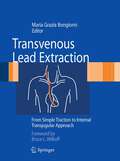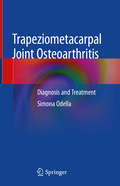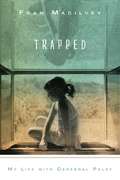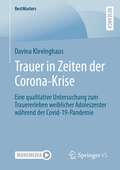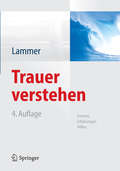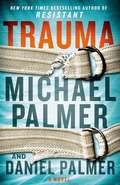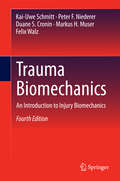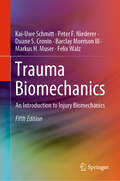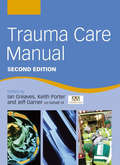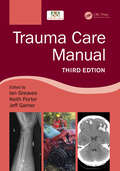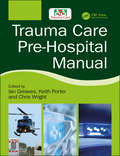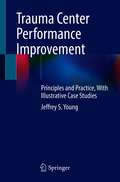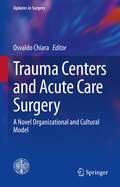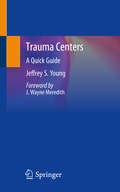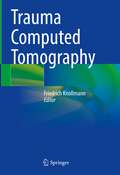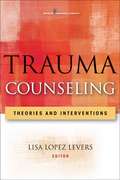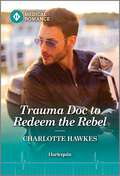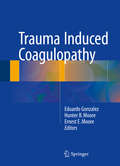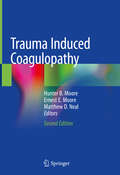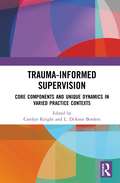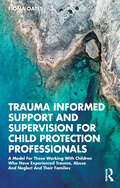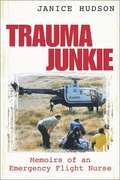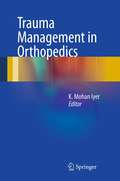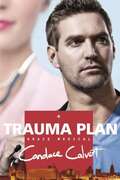- Table View
- List View
Transvenous Lead Extraction
by Maria Grazia BongiorniIn the last years, indications for defibrillators and cardiac resynchronization therapy have expanded enormously; for this reason, and also due to the extension of human life length, the number of patients with implanted cardiac devices have steadily increased. The leads implanted for the functioning of these devices, however, have a limited duration in time and more and more their extraction will be a frequent issue in clinical practice, in order to treat short- and long-term complications, such as infections and failures. Aim of this book is to provide readers with a state-of-the-art on lead extraction techniques. The chapters deal with leads characteristics, indications to lead removal, patient preparation, tools and techniques for extraction, and prevention and management of complications. In addition, a series of tips and tricks on how to treat some particular conditions (tight cost-clavicular space, fractured leads, ICD leads, dangered leads...etc.), are given. A new extracting technique, according to which the extraction is performed through the internal jugular vein is described; several examples are included and many figures provide a thorough depiction of this innovative procedure. The volume will be an excellent resource for all those involved in the management of cardiac patients: cardiologists, arrhythmologists, cardiac surgeons, GPs, pediatricians, and post-graduate students in these disciplines.
Trapeziometacarpal Joint Osteoarthritis: Diagnosis and Treatment
by Simona OdellaThis book describes the anatomy and biomechanics of the trapeziometacarpal joint and explains the pathogenesis and treatment of trapeziometacarpal joint osteoarthritis, also known as rhizarthrosis. The discussion of treatment sets out both conservative and surgical approaches, clearly explaining the indications for the various options, as well as their advantages and disadvantages. The trapeziometacarpal joint is a phylogenetically recent articulation that permits the pinching movements of the index finger and thumb so important in daily activities. Degenerative disease involving the trapeziometacarpal joint is an important disabling condition that affects predominantly females over 50 years old. Although a number of treatments are now available, there is no single gold standard. Conservative treatments can control pain yet are unable to halt progression of the articular aging, while none of the surgical solutions employed when conservative treatments prove insufficient can be considered perfect. For example, use of a spacer can restore strength but does not always completely alleviate pain while arthroplasty eradicates pain within a few weeks but cannot restore strength. In thoroughly reviewing the available treatments, this book will enable the practitioner to select the best option for the individual patient.
Trapped: My Life with Cerebral Palsy
by Fran Macilvey<p>An honest, unflinching, and inspiring memoir of living with a challenging disorder. <p> Fran Macilvery was born in the 1960s, when her parents were living in the Belgian Congo. Fran was the second of premature twins—and until the last moment, no one knew that twins were arriving. The complications and resulting delay led to Fran’s cerebral palsy. <p>Growing up with her siblings in Africa, Fran always felt different. When everyone else was playing and having fun, she would watch and wish she could join in. Eventually the family moved to Scotland and, as Fran grew older, her hurt turned into anger, self-hatred, and suicidal depression. Then one day, someone looked at her and saw a woman to love, and that was the start of her journey to self-acceptance. <p>A truthful and revealing look at the difficulty of maintaining the appearance of a “normal” life with CP, and the lessons learned along the way, Trapped is “an ideal firsthand account of the unique and largely unknown world of disability.</p>
Trauer in Zeiten der Corona-Krise: Eine qualitative Untersuchung zum Trauererleben weiblicher Adoleszenter während der Covid-19-Pandemie (BestMasters)
by Davina KlevinghausDie Covid-19-Pandemie tangiert das Alltagserleben zahlreicher junger Menschen in Deutschland mitunter gravierend. Wie kann es unter diesen Umständen gelingen, die Trauer nach dem Verlust einer nahestehenden Person in ein von Unabwägbarkeiten und radikalen Veränderungen geprägtes Leben zu integrieren? Welche Belastungen und Ressourcen rücken in Anbetracht der ubiquitären Bedrohung durch das Coronavirus besonders in den Fokus? Auf diese Fragen sowie auf weitere Spezifika des Trauererlebens weiblicher Adoleszenter im Zuge der Pandemie wird - rekurrierend auf Bezugstheorien der Trauer- und Stressforschung - der Schwerpunkt der vorliegenden Arbeit gerichtet. Die geführten Interviews deuten auf erhebliche interindividuelle Unterschiede im Pandemie- und Verlusterleben sowie in den Verarbeitungsformen der eigenen Trauer hin. Zugleich lassen sich zahlreiche geteilte Erfahrungen rekonstruieren. Insofern bieten die Analysen einen grundlegenden Reflexionsanlass im Hinblick auf die Partizipationsmöglichkeiten junger Menschen, den Zugang zu trauerbezogenen Unterstützungsangeboten sowie auf den gesamtgesellschaftlichen Umgang mit Sterben, Tod und Trauer.
Trauer verstehen: Formen, Erklärungen, Hilfen
by Kerstin LammerTrauer verstehenTrauernden wirksam helfen, ihren Verlust zu bewältigen und sich in einer veränderten Lebenssituation neu zu orientieren – das leistet professionelle Trauerbegleitung. Wie das geht, zeigt dieses Buch. Kurz und bündig werden die Ergebnisse neuerer internationaler Trauerforschung aufbereitet und zu einem Praxismodell entwickelt. Drei Querschnitte präsentieren: - Studien, die Formen der Trauer beschreiben,- Theorien, die Trauer psychologisch erklären,- Modelle, die Trauer bewältigen helfenMit vielen Schaubildern und Beispielen aus der Praxis.Formen, Erklärungen, HilfenDer Leser, die Leserin findet ein verständliches Buch, das mit Mythen über Trauerprozesse aufräumt und eine hilfreiche Basis für die Bewältigungsarbeit mit Betroffenen sein kann. Die Autorin identifiziert Aufgaben, die Trauernde nach dem Verlust eines für sie bedeutsamen Menschen bewältigen müssen. Sie entwickelt daraus – als geeignetere Alternative zu gängigen Phasenmodellen – ihr Aufgabenmodell der Trauerbegleitung:- Tod begreifen helfen (Realisation)- Reaktionen Raum geben (Initiation)- Anerkennung des Verlusts äußern (Validation)- Übergänge unterstützen (Progression)- Erinnern und Erzählen ermutigen (Rekonstruktion)- Risiken und Ressourcen einschätzen (Evaluation)Eine praxisnahe Basis für die professionelle Beratung Trauernder
Trauma
by Michael Palmer Daniel PalmerDr. Carrie Bryant's four years as a neurosurgical resident at White Memorial Hospital have earned her the respect and admiration from peers and staff alike. When given the chance of performing her first unsupervised brain surgery, Carrie jumps at the opportunity. What should have been a routine, hours long operation, turns horribly wrong and jeopardizes her patient's life. Emotionally and physically drained, Carrie is rushed back to the OR to assist in a second surgery. There, she makes a careless and tragic mental error resulting in irreparable brain damage to her second patient. With her confidence shattered, Carrie quits her residency and moves back home where her younger brother, Adam, a combat vet suffering from debilitating PTSD, also lives. When Carrie learns about an experimental program at the VA Medical Center exploring the use of Deep Brain Stimulation (DBS) that could forever cure the emotional and memory trauma of PTSD, it seems like a way back into medicine. Carrie is apprehensive, but a chance meeting with David Hoffman, a reporter for the Lowell Observer writing a story on PTSD, helps her overcome any hesitation. Her first surgery appears to be a success until her patient mysteriously vanishes. When a second patient also goes missing, Carrie employees the investigative skills of David, and together they descend into a labyrinth of murder and corruption. And the price Carrie might pay for asking the wrong questions could be her life.
Trauma Anesthesia
by MPH FACS Charles E. Smith Charles E. Smith Md John J. Como John J. ComoTrauma patients present a unique challenge to anesthesiologists, since they require resource-intensive care, often complicated by pre-existing medical conditions. This fully revised new edition focuses on a broad spectrum of traumatic injuries and the procedures anesthesiologists perform to care for trauma patients perioperatively, surgically, and post-operatively. Special emphasis is given to assessment and treatment of co-existing disease, including surgical management of trauma patients with head, spine, orthopedic, cardiac, and burn injuries. Topics such as training for trauma (including use of simulation) and hypothermia in trauma are also covered. Six brand new chapters address pre-hospital and ED trauma management, imaging in trauma, surgical issues in head trauma and in abdominal trauma, anesthesia for oral and maxillofacial trauma, and prevention of injuries. The text is enhanced with numerous tables and 300 illustrations showcasing techniques of airway management, shock resuscitation, echocardiography and use of ultrasound for the performance of regional anesthesia in trauma.
Trauma Biomechanics
by Kai-Uwe Schmitt Peter F. Niederer Duane S. Cronin Markus H. Muser Felix WalzFor the 4th edition of Trauma Biomechanics all existing chapters referring to traffic and sports have been revised and updated. New scientific knowledge and changes in legal defaults (such as norms and standards of crash tests) have been integrated. Additionally one chapter has been added where biomechanical aspects of injuries affected by high energies are communicated in a new way The mechanical basics for ballistics and explosions are described and the respective impacts on human bodies are discussed. The new edition with the additional chapter therefore is addressed to a broader audience than the previous one.
Trauma Biomechanics: Accidental Injury In Traffic And Sports
by Kai-Uwe Schmitt Peter F. Niederer Duane S. Cronin Markus H. Muser Felix Walz Barclay Morrison IIIThis well-established book on injury biomechanics has been extensively revised and expanded for this new edition. It now includes a fundamental treatment of the mechanics at a cellular level, written by the new coauthor Prof. Barclay Morrison III from Columbia University. Furthermore, considerably more attention is paid to computer modeling, and in particular modeling the human body. <P><P> The book addresses a wide range of topics in injury biomechanics, including anatomy, injury classification, injury mechanisms, and injury criteria. Further, it provides essential information on regional injury reference values, or injury criteria, that are either currently in use or proposed by both US and European communities. Although the book is intended as an introduction for doctors and engineers who are newcomers to the field of injury biomechanics, sufficient references are provided for those who wish to conduct further research, and even established researchers will find it useful as a reference guide to the biomechanical background of each proposed injury mechanism and injury criterion.
Trauma Care Manual
by Keith Porter Ian Greaves Jeff GarnerThe Trauma Care Manual was first published in 2000, and was the first evidence-based manual of best trauma practice. Now in its second edition, it continues to offer clear and practical guidelines for the management of victims of major trauma, reflecting current practice in the United Kingdom and Europe.The second edition benefits from an increase
Trauma Care Manual
by Keith Porter Ian Greaves Jeff GarnerThe Trauma Care Manual 3e is the definitive evidence-based manual of best trauma practice. Now in its third edition, this valuable book continues to provide clear practical guidelines for the management of victims of major trauma. New coverage includes chapters on abdominal and urological trauma, aswell as trauma in the obese patient. Also included is coverage of pre-hospital management; trauma centres, sytems & teams; modern trauma resuscitation; trauma physiology & metabolism; damage control surgery. Written by members of Trauma Care, this book offers a nationally accepted set of standards for good practice.
Trauma Care Pre-Hospital Manual
by Chris Wright Keith Porter Ian GreavesThis new book provides evidence based guidelines for the immediate clinical management of major trauma.It has been written by clinicians with many years of trauma experience, and endorsed as authoritative by Trauma Care (UK). The UK now has highly effective trauma systems. Clinical developments include the introduction of damage control resuscitation, tranexamic acid, blood product resuscitation, novel hybrid resuscitation and an emphasis on the control of major external haemorrhage as part of a new ABCDE approach. Consequently, more individuals with major trauma are surviving than ever before. Optimal pre-hospital care is essential for improved survival rates and reduced morbidity.
Trauma Center Performance Improvement: Principles and Practice, With Illustrative Case Studies
by Jeffrey S. YoungManaging a trauma center involves complex clinical care, long nights and days, administrative work, self-examination, critical review of patient care and significant regulatory requirements. Performance improvement is the key element of trauma center effectiveness. No trauma center provides flawless care, thus all centers have opportunities to improve. A competent performance improvement program is critical to trauma center outcomes.This book provides key information on all aspects of trauma PI and program management. In some ways, PI is an art more than a science, so the more interaction program leaders have with strong PI programs, the more they can learn about how to improve their processes. The book outlines the generally accepted processes for identification of opportunities for improvement, which are the key component of performance improvement. This includes: rounding with care teams, contemporaneous chart review, audit filters, and voluntary submissions to the trauma program for review.This book explains how to triage opportunities for improvement, analyze them, form corrective actions, and finally achieve loop closure. The book covers the roles of the personnel in the PI program, what is required to dissect the opportunity to determine action plans, how to document the entire process, and how to keep track of opportunities for improvement to ensure that your program is progressively improving care. The final sections of the book deal with specific opportunities for improvement, action plans, and loop closure through the use of case studies. The book serves as a follow-up to Dr. Jeffrey Young’s recently published book Trauma Centers, which serves as a quick guide to the key components of trauma center administration, management, and patient care.
Trauma Centers and Acute Care Surgery: A Novel Organizational and Cultural Model (Updates in Surgery)
by Osvaldo ChiaraThis book offers an overview of acute care surgery around the world, focusing on the four main branches of this novel subdiscipline: trauma, general emergencies, critical care, and rescue surgery. The book’s primary goal is to provide a general view of acute care surgery, while addressing the most important issues in depth.The content is divided into three parts, the first of which is dedicated to the general organization of trauma centers, including the composition of modern trauma teams. Protocols of activation and action for the trauma team, as well as damage control procedures both in the emergency room and in the surgical theatre, are described. The book also addresses the development of a trauma registry, together with the quality assessment process that can be applied.In turn, the second part describes the principal protocols for making diagnoses, with special attention to circumstances such as unstable hemodynamics, neurological deterioration, normal vital signs, and penetrating injuries. The book subsequently deals with the most important aspects of trauma to the abdomen, chest, and pelvis, with notes on both surgical and intensive care issues. Practical descriptions of how to treat principal injuries to various organs are also provided. Finally, the third part of the book is dedicated to the most frequent general surgical emergencies and rescue surgical approaches, and includes information on diagnostic support with point of care ultrasound and endoscopic advanced techniques. Presenting cutting-edge strategies, this book will be of interest to professionals involved in surgical and intensive care for emergency conditions, such as colonic perforations, obstructions, acute pancreatitis, biliary tree stones, and caustic injuries.
Trauma Centers: A Quick Guide
by Jeffrey S. YoungThis book is a quick guide to the key components of trauma center administration, management, and patient care. This book provides essential information for hospitals working toward trauma center designation, and for established trauma centers who want to improve their performance. This book provides trauma center personnel with a comprehensive overview of trauma center administrative structure, basic clinical operations, performance improvement and site visit preparation and examines the most common critical injuries seen by trauma centers to demonstrate how a properly functioning center addresses multiple priorities in critically ill patients. This book provides critical information for hospitals looking toward becoming a trauma center and established trauma centers that wants to improve their performance.
Trauma Computed Tomography
by Friedrich KnollmannThis book covers the use of computed tomography in trauma care. Over the last two decades, advancements in CT technology have significantly changed the technique and utilization patterns of computed tomography in trauma imaging. This book covers the entire spectrum of this application, structured by organ systems/body areas, corresponding to the subject structure and practice pattern of large academic radiology departments in the US. As a result, the reader benefits from the most advanced currently available sub-specialty expertise in the performance and interpretation of trauma CT studies. The book is intended to serve as an introduction to the subject as well as a reference to the trauma radiologist. Since current post graduate education in radiology does not offer any formally regulated fellowship training in this area, fellowship trained radiologists are typically not trained to cover the entire spectrum of trauma imaging that the practitioner may encounter when covering call assignments, especially outside of highly subspecialized academic medical centers. This book is intended to fill a need to provide subspecialized trauma CT training by integrating contributions from all involved radiology subspecialties in a single volume. This is an ideal guide for radiology residents, fellows, practicing radiologists, trauma surgeons, emergency medicine specialists, surgery residents and fellows, and interested medical students.
Trauma Counseling: Theories and Interventions
by Lisa Lopez LeversTrauma Counseling: Theories and Interventions is a much-needed textbook that focuses on relevant issues of traumatic, crisis-related, and disaster events from a systemic paradigm. The book discusses evidence-based trauma assessment and intervention techniques and integrates the latest findings from neuropsychology and psychopharmacology.
Trauma Doc to Redeem the Rebel
by Charlotte HawkesSparks fly with the trauma doc…but could she be the one to heal him? Find out in Charlotte Hawkes&’s latest Harlequin Medical Romance novel! WILL LETTING GO SET HIM FREE? Former army surgeon Connor is instantly drawn to ER doc Nell. She&’s beautiful, intelligent and the first person to really see him—ever. Rebel Connor has spent years running away from his painful past, relationships and himself. But since Nell understands being abandoned in childhood, as he was, could she be the one woman to finally break through his barriers…and redeem his barricaded heart?From Harlequin Medical: Life and love in the world of modern medicine.
Trauma Induced Coagulopathy
by Eduardo Gonzalez Hunter B. Moore Ernest E. MooreThis text is aimed at defining the current concepts that define trauma induced coagulopathy by critically analyzing the most up-to-date studies from a clinical and basic science perspective. It will serve as a reference source for any clinician interested in reviewing the pathophysiology, diagnosis, and management of the coagulopathic trauma patient, and the data that supports it. By meticulously describing the methodology of most traditional as well as state of the art coagulation assays the reader will have full understanding of the tests that are used to study trauma induced coagulopathy. The evolving use of blood products as well as recently introduced hemostatic medications are reviewed in detail. Trauma Induced Coagulopathy will also be a valuable source for quick reference to the clinician that is faced with specific clinical challenges when managing coagulopathy.
Trauma Induced Coagulopathy
by Hunter B. Moore Ernest E. Moore Matthew D. NealThe first edition of this publication was aimed at defining the current concepts of trauma induced coagulopathy by critically analyzing the most up-to-date studies from a clinical and basic science perspective. It served as a reference source for any clinician interested in reviewing the pathophysiology, diagnosis, and management of the coagulopathic trauma patient, and the data that supports it. By meticulously describing the methodology of most traditional as well as state of the art coagulation assays the reader is provided with a full understanding of the tests that are used to study trauma induced coagulopathy. With the growing interest in understanding and managing coagulation in trauma, this second edition has been expanded to 46 chapters from its original 35 to incorporate the massive global efforts in understanding, diagnosing, and treating trauma induced coagulopathy. The evolving use of blood products as well as recently introduced hemostatic medications is reviewed in detail. The text provides therapeutic strategies to treat specific coagulation abnormalities following severe injury, which goes beyond the first edition that largely was based on describing the mechanisms causing coagulation abnormalities.Trauma Induced Coagulopathy 2nd Edition is a valuable reference to clinicians that are faced with specific clinical challenges when managing coagulopathy.
Trauma Informed Supervision: Core Components and Unique Dynamics in Varied Practice Contexts
by Carolyn Knight Di BordersSurvivors of trauma are disproportionately represented in agencies providing a broad range of behavioral, social, and mental health services. Practitioners in these settings must understand and be able to respond to survivors of trauma in ways that are empowering, normalize and validate their experiences and reactions, and minimize the risk of retraumatization. Practitioners also will be indirectly traumatized as a result of their work with trauma survivors. <p><p> Practitioners’ ability to help clients with histories of trauma depends upon clinical supervision that is trauma-informed. The trauma-informed supervisor has the dual responsibility of enhancing supervisees’ skills as trauma-informed practitioners and helping them manage the impact their work has on them. <p> Nevertheless, many clinical supervisors only have limited knowledge and training in trauma and may not recognize either the needs of those whom they supervise or the clients their supervisees serve. This book compiles important recommendations from trauma-informed practitioners, supervisors, and researchers who share their professional reflections and personal stories based on their hands-on experiences across mental health and medical contexts.
Trauma Informed Support and Supervision for Child Protection Professionals: A Model For Those Working With Children Who Have Experienced Trauma, Abuse And Neglect And Their Families
by Fiona OatesThis book presents a narrative approach to creating a supportive environment for health and human service practitioners who work with vulnerable children and their families—one of the most difficult and complex areas of practice. People working in these environments are routinely exposed to violence and trauma and commonly experience symptoms of traumatic stress as a result. Traditionally, human service and health care service organisations have struggled to support practitioners who experience primary and secondary trauma in either a preventative context or post exposure. Using contemporary trauma theory, this book provides a trauma-informed support and supervision framework for supervisors and managers of practitioners that recognises the uniqueness of the practice field, the diversity of practitioners who undertake the work and the diversity of contexts in which they work. It will be required reading for all human service and health professionals, including social workers, psychologists and nurses as well as teachers, counsellors and youth workers.
Trauma Junkie: Memoirs of an Emergency Flight Nurse
by Janice HudsonMemoirs of a flight nurse on a helicopter sent out to take trauma patients to hospitals in California.
Trauma Management in Orthopedics
by K. Mohan IyerThis book has been written by established Orthopedic Surgeons who have become dedicated specialists within their particular subspecialty. They have contributed by writing highly detailed chapters that educate the reader with the basic science, accepted fundamentals and most recent trends within the full range of trauma management in orthopedics. It is intended that this well illustrated and highly informative text book to provide orthopedic surgeons in training with comprehensive and relevant core knowledge on all aspects of trauma management orthopedics, and will become an essential guide for surgeons in training, providing step by step approaches to performing initial diagnosis, surgical procedures and post operative management.
Trauma Plan (Grace Medical Ser. #1)
by Candace CalvertSidelined by injuries from a vicious assault, chaplain Riley Hale is eager to return to her former duties as an ER nurse. But how can she show she's competent when the hospital won't let her attempt even simple tasks? Determined to prove herself, Riley volunteers at a controversial urban free clinic despite her fears about the maverick doctor in charge. Dr. Jack Travis defends his clinic like he's commander of the Alamo. He'll fight the community's efforts to shut its doors, even if he must use Riley Hale's influential family name to make it happen. As Riley strives to regain her skills. Jack finds that she shares his compassion--and stirs his lonely heart. Riley senses that beneath Jack's rough exterior is a man she can believe in. But when clinic protests escalate and questions surface about his past, Jack goes into battle mode, and Riley wonders if it's dangerous to trust him with her heart. Heart-stopping and... heart melting. A great read and one for your keeper shelf."--LYNETTE EASON, award-winning, bestselling author of the Women of Justice series--
